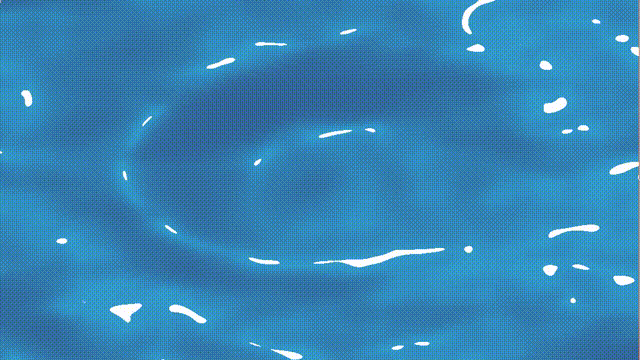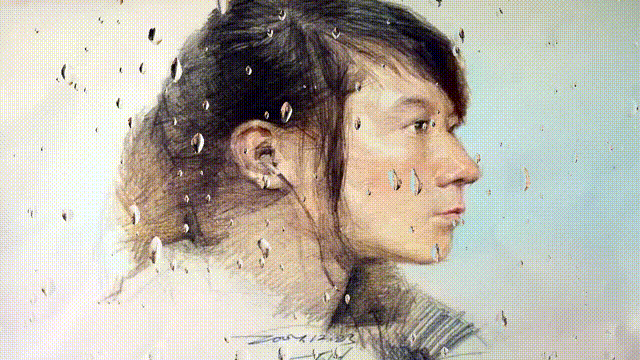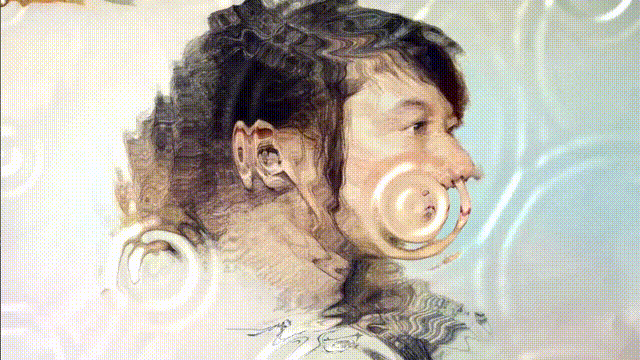Shader code
shader_type canvas_item;
#define iResolution 1.0/SCREEN_PIXEL_SIZE
#define iTime TIME
#define fragColor COLOR
uniform float uv_scale : hint_range(0.0, 10.0, 0.1) = 1.0;
uniform float color_alpha : hint_range(0.0, 1.0, 0.1) = 1.0;
vec2 hash( vec2 p ) // replace this by something better
{
p = vec2( dot(p,vec2(127.1,311.7)), dot(p,vec2(269.5,183.3)) );
return -1.0 + 2.0*fract(sin(p)*43758.5453123);
}
float noise( in vec2 p )
{
const float K1 = 0.366025404; // (sqrt(3)-1)/2;
const float K2 = 0.211324865; // (3-sqrt(3))/6;
vec2 i = floor( p + (p.x+p.y)*K1 );
vec2 a = p - i + (i.x+i.y)*K2;
float m = step(a.y,a.x);
vec2 o = vec2(m,1.0-m);
vec2 b = a - o + K2;
vec2 c = a - 1.0 + 2.0*K2;
vec3 h = max( 0.5-vec3(dot(a,a), dot(b,b), dot(c,c) ), 0.0 );
vec3 n = h*h*h*h*vec3( dot(a,hash(i+0.0)), dot(b,hash(i+o)), dot(c,hash(i+1.0)));
return dot( n, vec3(70.0) );
}
#define MAX_WAVES 4
#define SUPERPOSITION 4
#define TAU 6.28318
#define PHI 1.618
// closed form normal would increase performance a lot
float height(vec2 p, float t) {
float acc = 0.0;
for (int i = 0; i < MAX_WAVES; i++) {
for (int j = 0; j < SUPERPOSITION; j++) {
int seed = i + 5*j;
//float theta = TAU * noise(vec2(0.01 * t, 10.0*float(i)));
float theta = TAU * PHI * 10.0*float(seed);
float up = cos(theta) * p.x - sin(theta) * p.y;
float vp = sin(theta) * p.x + cos(theta) * p.y;
//float initial_phase = TAU * noise(vec2(0.0, 2.0*float(i))) + cos(vp);
float initial_phase = TAU * PHI * float(seed);
//float k = pow(2.0, float(i)*0.1) + 0.5;
//float k = pow(2.0, 1.0 + 0.4*float(i));
float k = pow(2.0, float(i));
//float k = float(i+1);
float phase = initial_phase + up*k + cos(vp) + 3.0*t + 0.5*k*t;
// its kinda like choose your artifacts, probably use noise for vp
float A = cos(phase)/(k*k);
acc += A;
}}
return acc;
}
vec4 hn_fdm(vec2 p, float t) {
float h = height(p, t);
vec2 vx = vec2(0.1, 0.0);
vec2 vy = vec2(0.0, 0.1);
float hx = height(p+vx, t);
float hy = height(p+vy, t);
float dx = (hx - h);
float dy = (hy - h);
// vec3 norm = normalize(vec3(-dx, -dy, dx+dy));
// vec3 norm = normalize(vec3(-dx/vx.x, -dy/vy.y, 1.0));
vec3 v1 = normalize(vec3(vx.x, 0.0, dx));
vec3 v2 = normalize(vec3(0.0, vy.y, dy));
vec3 norm = cross(v1, v2);
return vec4(norm, h);
}
void fragment()
{
vec2 uv = UV;
vec2 uv_screen = (uv - 0.5) * uv_scale;
vec4 nh = hn_fdm(uv_screen* 10.0, iTime * 1.0);
float h = nh.w;
vec3 norm = nh.xyz;
vec3 sun_dir = normalize(vec3(-0.2, 0.4, 1.0));
vec4 water_colour = vec4(0.2, 0.4, 0.6, 1.0);
vec4 foam_colour = vec4(0.8, 0.9, 1.0, 1.0);
vec4 sky_colour = vec4(0.2, 0.6, 0.8, 1.0);
vec4 specular_colour = vec4(1.0, 1.0, 1.0, 1.0);
//fragColor = vec4(norm.xyz, 1.0); return;
if (dot(sun_dir, norm) > 0.98) {
fragColor = specular_colour;
} else {
fragColor = mix(water_colour, sky_colour, dot(norm, normalize(vec3(0.0, 0.2, 1.0))));
}
fragColor.a = color_alpha;
}









Very cool, thanks for sharing!
It is possible to make it interactive? I’m thinking of initiating waves with mouse cursor
I used this for making a liquid progress bar shader in case you are interested, you can find it here.
https://godotshaders.com/shader/liquid-progress-bar/